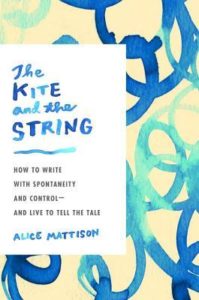 Writers don’t need rules as much as we need the freedom to take risks and to make simple decisions for simple, practical reasons. If a piece of writing is a kite that the strong winds of feeling are blowing across the sky, we need a string to grasp. We need freedom above all, but we also need control
Writers don’t need rules as much as we need the freedom to take risks and to make simple decisions for simple, practical reasons. If a piece of writing is a kite that the strong winds of feeling are blowing across the sky, we need a string to grasp. We need freedom above all, but we also need control
I’m reading about writing, because I’m writing again.
I’ve read a lot of books on the topic over the years. Perhaps I’ve been longing to find the holy grail, the ultimate guide to better, quicker, more efficient fiction writing. Certainly, some of the books I’ve read market themselves this way. Story engineering; nuts and bolts manuals; if you do this, and this, and this – voila! not just 65,000 words but a shapely, structured, novel. It’s seductive.
I have tried. I really have. I love the idea of sitting at my computer for my writing session knowing exactly what’s going to happen and happily tap-tap-tapping away until it has.
Alas, my few experiments with this kind of superior planning have been notable failures. I’ve felt constricted. My characters veer off the straight and narrow plot paths into unexpected and unplanned-for directions. I had to ditch a disappointingly large chunk (around 15,000 words and many, many hours of research) of one of the Verity Sparks novels because my sub-plot didn’t work. I mean, for me. It was exciting and mysterious and dovetailed beautifully into the main story but it just wasn’t right. Disappointing, but as I always tell myself, in writing nothing’s lost. (This is the compost theory of creativity!)
I also know that outlines, timelines, story maps, story blueprints, diagrams, character arcs and all of the other planning tools can be useful to me once I’ve got started, if I’m in a mid-book slump, and especially when looking over a messy first draft. I’ll give a little shout out to Story Genius: How to Use Brain Science to Go Beyond Outlining and Write a Riveting Novel by Lisa Cron. I’ve found some of her pre-writing exercises really helpful, even if I’ve done them post- instead of pre-writing.
I guess that really, I know what to do – it’s bum on seat, mainly – but it’s always good to have a little wind in your sails.
This book – subtitled How to Write with Spontaneity and Control – and Live to Tell the Tale – by Alice Mattison is like having a long conversation with a kindly, calm, ‘older and wiser’ fellow writer. A mentor. She wants the reader/writer to approach their work with ‘more confidence, excitement and hope’.
The qualities a writer primarily needs, both you and I – not just in order to sit down on the chair but to produce good work – are emotional as much as intellectual. Often the next task is not to learn a technique but to find the courage to use one you already know. New writers speak of the need to find the courage to write, but once they’ve shown up at an MFA program or a writer’s conference…they may think that the emotional work is done and they can now follow prescribed rules…if only they can find out what those rules are.
Writers must be at peace with the process, so they trust themselves when they come up with an idea for the next scene – which may well turn out to be wrong, but which may suggest something right. We need the courage to waste time, even though we have so little of it. It takes time to discern what’s obscured in the dark at the back of the mind, but it is what the piece needs…
I’ve come away from reading this book encouraged to persevere with my own process, even though it’s often messy and time-wasting. Courage, mon capitaine! as my dear old Dad used to say.
Bum on seat, Susan – you’ll get there in the end.
